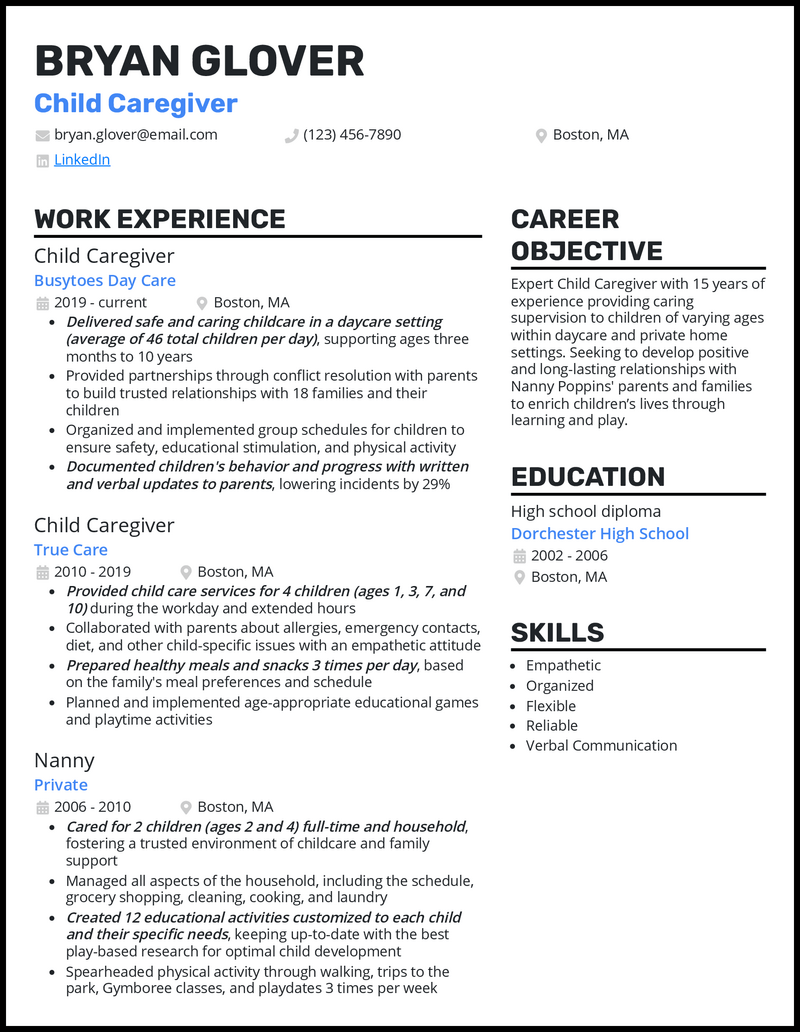As a child caregiver, your training and experience in childcare grant you the well-earned trust of children and adults alike. With childcare centers and daycares being your native habitat, you’re entrusted with precious, precocious littles while their parents are otherwise occupied.
Ready to build a resume that will convince recruiters that you’re the best candidate for the job? You can also take an inspiration from these resume examples and be on your way to scoring your dream position.
Since you’re busy keeping an eye on your charges, we’ll look after you. Check out our five child caregiver resume guide plus an instant cover letter generator and let us help you land your next child caregiver role.
Related resume examples
What Matters Most: Skills & Work Experience

Recruiters look for child caregivers who are comfortable tending to kids as part of their day-to-day responsibilities.
In your resume, show your next employer how you don’t just have patience when it comes to childminding, you also have the physical strength and stamina to keep up with rambunctious kids all day.
Here are some of the most popular child caregiver skills recruiters are looking for.
9 most popular child caregiver skills
- Behavior analysis
- Classroom guidance
- Confidentiality
- CPR
- First Aid Certified
- Housekeeping
- Planning & instruction
- Physical stamina
- Childhood development
Sample child caregiver work experience bullet points
Your work experience section is where you’ll show the reader how you did in your past roles. Here, you’ll provide context to the skills you listed earlier in your resume.
While it’s not easy to quantify your contributions as a child caregiver, any metrics and figures will help the recruiter better visualize what your work experience is like. If you helped with conflict resolution in the playground, try phrasing it like this: “Supported conflict resolution practices for 20 children aged between 5 and 10 years old”.
Here are a few samples:
- Delivered safe and caring childcare in a daycare setting (average of 46 total children per day), supporting ages three months to 10 years
- Documented children’s behavior and progress with written and verbal updates to parents for 53 families, lowering incidents by 29%
- Created 12 educational activities customized to each child and their specific needs and used them on rotation thrice weekly, keeping up-to-date with the best play-based research for optimal child development
- Collaborated with parents from 47 families about allergies, emergency contacts, diet, and other child-specific issues with an empathetic attitude
- Organized and implemented group schedules for 36 children ages three months to 8 years to ensure safety, educational stimulation, and physical activity
Top 5 Tips for Your child caregiver resume
- Keep specific and relevant job requirements at the top of your resume sections
- Some positions need specific things, such as experience with special needs. Job descriptions will provide clues by listing their skills requirements in order of priority, so make sure to list your most important and relevant skills first to catch the recruiter’s eye.
- Highlight your work experience with a reverse chronological resume format
- If you have loads of experience answering incessant “why?” questions under your belt, using the reverse chronological resume format will help you show the recruiter that you have what it takes to shine in your next child caregiver role. Meanwhile, a functional resume format will work better for entry-level positions, as that better highlights your skills.
- Nontechnical skills are just as valuable as your qualifications
- Don’t worry if you can’t fill your skills section with specialized early childhood education training skills – transferable skills will also work in a pinch. Add more context to these skills by highlighting them in your work experience bullet points, like this: “Lifted 30lbs regularly as part of childminding duties during work shifts five days a week”.
- Keep your resume to one page unless you have more than 10 years of experience
- Time is of the essence when it comes to childcare, especially if you’re tending to more than one wriggly toddler at a time. Keeping your resume short and sweet shows the recruiter that you know how to quickly and effectively communicate important information. If you have more than 10 years of experience, your resume can stretch to two pages.
- Follow up with your potential employer after you’ve applied for the job
- Once you’ve submitted your resume, close the loop by sending an email or calling to check in with the recruiter. This shows that you’re committed to following through and allows you to troubleshoot any issues that might pop up, all of which are appreciated in child caregiver job applicants.
Yes – child caregivers have to work in person, so you’ll be commuting to your workplace unless you are providing the care from your own home. Noting your location and paying attention to the job description requirements will help you manage expectations when applying for a child caregiver position.
Depending on where you’re applying to, your job application will most likely go to a recruiter. However, you might also be applying to work directly at a daycare or a childcare center. In that case, try looking up the hiring manager or the care team lead and address your resume to them instead.
Yes, you should – listing your high school diploma or GED will help you cover all your bases. If you happen to have a background in early childhood education or an equivalent field, including this in your resume will also help you get hired.










